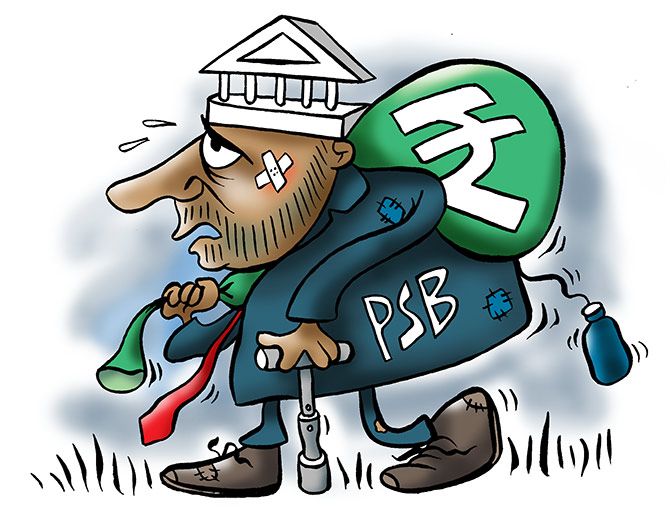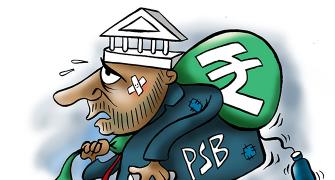The banking sector's credibility is on thin ice.
Unless the government takes strict steps, things could get worse.
Joydeep Ghosh and Anup Roy report.

Illustration: Uttam Ghosh/Rediff.com
In less than a fortnight, the credibility of public sector banks, which commands about 70% share of the bank loan market, took a serious hit. And three incidents have contributed to this fracas.
First, the country's largest bank -- the State Bank of India -- reported its first quarterly loss in 19 years.
Second, Bank of Baroda's decision to shut operations in South Africa.
BoB came under the scanner after it emerged in April 2016 as the only bank willing to do business with the Gupta brothers -- Ajay, Atul, and Rajesh –- who are accused of benefiting unduly due to their closeness to former South African president Jacob Zuma and his family members.
Three, the Rs 114 billion fraud in the Punjab National Bank through letters of undertaking issued to jewellery designer Nirav Modi and Gitanjali Group.
No wonder, the Nifty PSU Bank Index has fallen 17% in the past month, and there are expectations that things may worsen.
"The PNB fraud is definitely a shock. As far as cases like Vijay Mallya or the Gupta brothers go, the board of the bank had made the decisions to lend. That is still a comfort. In PNB's case, it seems only two-three employees were aware. This is quite different and much more difficult to understand," said a former Reserve Bank of India deputy governor.
According to him, the banking sector's credibility is on thin ice. Unless the government takes strict steps, things could get worse.
This crisis comes at a time when there was a feeling that the government's Rs 2.11 trillion recapitalisation largesse would provide enough 'growth capital' to banks to kick-start the economy suffering from the dual shocks of demonetisation and the goods and services tax.
SBI Chairman Rajnish Kumar recently told the World Economic Forum in Davos that the bank would use the entire amount it receives -- Rs 88 billion -- from the government's package to fund growth.
Now, it seems, these numbers may not be enough and the 'growth capital' that banks get would be spent more on provisioning and cleaning up their books.
Sample this: The government was planning to give PNB Rs 57 billion for recapitalisation. The fraud is double that figure.
In its third quarter results, SBI said there was a divergence between the assessment of non-performing assets of the RBI and the bank's and there was a difference of more than Rs 230 billion at the end of FY17 and the burden of provisioning for this was more than Rs 60 billion.
That's not all. With the RBI banning all debt recast plans, around Rs 2.8 trillion worth of loans, where payments have remained outstanding for 60 to 90 days, are under threat of becoming NPAs. This implies significantly higher provisioning.
"With the government being the majority owner of PSBs, any additional loss on account of higher NPAs due to additions in the new NPA resolution scheme or due to extraneous reasons has to be covered by additional infusion of capital over and above the Rs 2.11 trillion. This will hold more so, if any bank is unable to make provisions from internal funds," said Madan Sabnavis, chief economist, Icra.
There are doubts on whether the recapitalisation will work.
Says Nilesh Shah, managing director, Kotak Mutual Fund: "The recapitalisation package announced is likely to be inadequate for some reasons. PSBs have incurred more than the anticipated treasury losses due to rising yields; the new circular from the RBI to close various packages in favour of one single way of treating NPA is likely to increase NPA and the need for provisioning; there could be higher provisioning on cases referred in the National Company Law Tribunal. It is also corroborated from the announcement of capital-raising from a few PSBs."
According to him, the main issue is compensation of top management of PSBs and the administrative freedom to do the work without external influence.
"The market will provide as much capital as PSBs need if the above two issues are tackled on a permanent basis," added Shah.
What may come as a respite is that raising funds from abroad, though costlier, may not pose any challenge.
The cost increase won't be because of the recent fiasco, but spreads have generally gone up.
"Our macros are worse than a year ago, with rising twin deficits, commodity prices, and the uncertainty of the upcoming elections. However, as of now, global investors still see India as a bright, long-term story," says Ananth Narayan, professor, SP Jain Institute of Management Research.
"While headlines such as the PNB scam are irritants, investors are sensible enough to look through short-term hiccups. Global fixed income investors appear to be more optimistic about our prospects than their domestic counterparts," points out Professor Narayan.
On the other hand, the banking sector's NPAs woes are unlikely to recede soon.
On a gross basis, Indian banks added a whopping Rs 4.16 trillion of bad debt in financial year 2016-2017, out of which Rs 3.28 trillion belonged to PSBs, the RBI data showed.
The banks wrote off Rs 1.08 trillion, and recovered Rs 1.3 trillion, taking the system-wide gross NPAs to about Rs 8 trillion, or about 9.3% of the loan book.
The estimates of stressed assets in the system vary, with some projecting it to about 14% of the total loan book.
Even as the insolvency proceedings were to bring the lid on such abysmally high bad debt numbers, the haircuts to be incurred by banks make the process difficult for lenders.
The first case where insolvency proceedings succeeded was in the case of Synergies Dooray, where bankers were told to take a 97% haircut.
Add to that, the revised stressed assets framework by the RBI 'could imply higher slippages and provisioning for FY18/FY19 -- the new scheme is applicable for existing stressed accounts under resolution as well, and will warrant higher provisioning if not resolved as they move to the Insolvency and Bankruptcy Code,' Morgan Stanley said in a report.
All these would have been fine if banks really had money to set aside.
The government has earmarked Rs 880 billion as recapitalisation to PSBs in this fiscal year. Clearly, that would not be enough.
The large 40 accounts itself on the list of the RBI required banks' total provisioning of at least Rs 2 trillion, roughly about half of which has already been provided for.
With several banks reporting high bad debts, and as capital adequacy dips in these banks, the RBI is imposing prompt corrective action.
Currently, 11 PSBs, including Bank of India, are under PCA. When under PCA, a bank cannot take large loan exposures, and this affects the economic activity of the country itself.
RBI Deputy Governor Viral Acharya recently said that the resolution is something that would give impetus to the economic recovery through uncluttered balance sheet of banks.
The question: How much time will it take?









